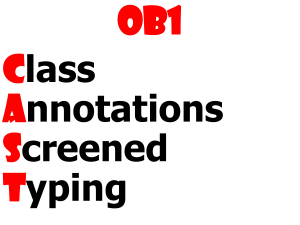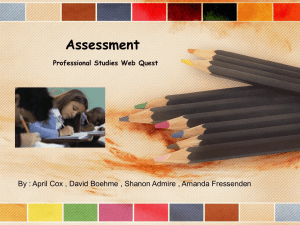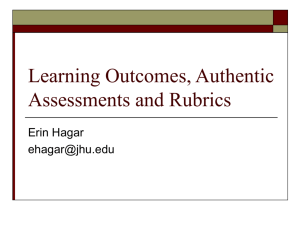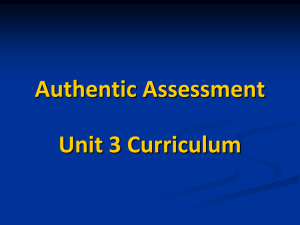Assessment
advertisement
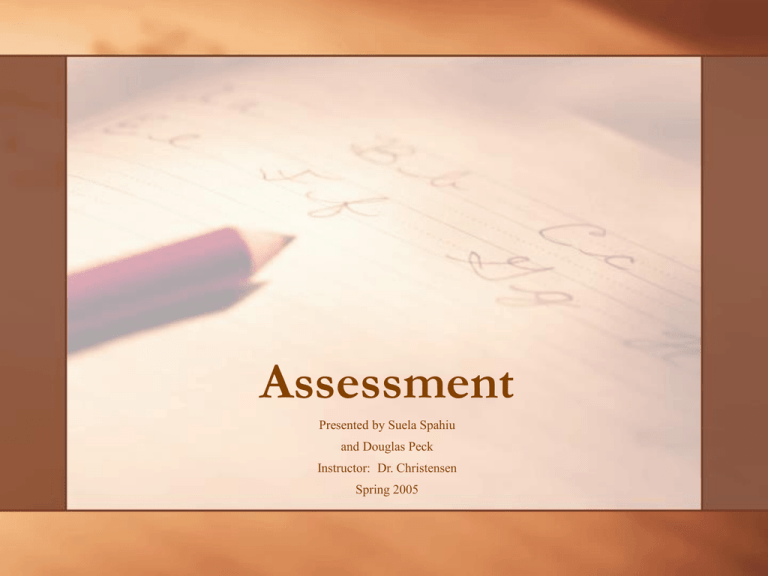
Assessment Presented by Suela Spahiu and Douglas Peck Instructor: Dr. Christensen Spring 2005 Learning and Assessment • “Understanding is not cued knowledge; performance is never the sum of drills; problems are not exercises; mastery is not achieved by the unthinking application of algorithms. In other words we can not be said to understand something unless we can employ our knowledge wisely, fluently, flexibly, and aptly in particular and diverse contexts.” By Grant Wiggins Assessment Latin “assidere”, to sit beside Collection of data… that enlightens teacher and student… provides information that drives instruction… part of learning process… reflection and autobiographical understanding of progress… Assessments Traditional: “Right answer, regardless of reasons.” Pencil and paper tests. Performance: Students put learning into meaningful context and demonstrate what they know. Portfolios, mural, stories presentations… Authentic: Directly examine student performance on worthy tasks that are real and meaningful to the learner in the today’s world . Looks as natural as possible. Contrasting Traditional and Authentic/Performance Assessment TRADITIONAL Sequence of simple, distinct tasks Recall of limited amounts of knowledge Quick/easy to score objectively AUTHENTIC General/complex task with interrelated sub-tasks Internalization/application of knowledge and thinking processes Scoring uses complex somewhat subjective considerations Tests depth of knowledge better Tests breadth of knowledge Easy to compare scores Easy to standardize for students regardless of their differences Scores are contextual, difficult to compare Adapts to strengths/needs/choices of unique students Low-level thinking to arrive at one right answer Encourages critical/creative thinking, taking time to arrive at best of several answers Reactive response, with student in isolation Students involved cooperatively in productive processes Reflective of prior teaching Enabling and forward-looking Authentic Assessment in the Classroom Authentic assessment is based on constructivist theories of learning. Learning is a constructive process in which the learner develops representations of knowledge and develops understandings of meaning based on personal experience. Authentic assessments focused not whether or not students can use the skills and strategies, but whether or not they can acquire the disposition to use the skills and strategies and apply them appropriately Authentic assessments require students to be effective performers with acquired knowledge. Traditional tests aren’t very wise to measure the students performance due to the fact that this tests only measure concepts they have retained such as recognizing or recalling information. Authentic Assessment in the Classroom • Synthesizes with classroom instruction; relates more closely to classroom learning; teaches students to evaluate their own work; uses samples of student work (portfolios) collected over an extended time period • Authentic assessment is often based on performance: Students are asked to demonstrate their knowledge, skills, or competencies in whatever way they find appropriate • There are several challenges when using authentic assessment methods. Examples of Authentic Assessments Plan and conduct an experiment. Write a story, composition, or poem. Give an oral report. Design and make a videotape. Construct a scientific model. Program a computer. Tutor a classmate. Keep a science journal. Interview a scientist. Guide classmates on a trip. Examples of Authentic Assessments, Continue…. Graph data. Construct a concept map. Research information in the library. Complete an art project. Draw a chart or diagram. Give photo or slide presentations. Compose a song. Write science questions. Record long-term plant growth. Care for/keep record of animals. Different Forms of Authentic Assessment Formal Assessment— provide teachers with systematic ways to evaluate how well students are progressing in particular instructional program. Allows teachers to evaluate all the students systematically the important skills and concepts in the theme by using real reading and writing experience that fit with the instruction. Continue….. Informal Assessment— include special activities such as group or individual projects, experiments, oral presentation, or performance. Performance Assessment in the Classroom Key Feature of Performance Assessment Students construct rather than select responses Allows teachers to observe students behavior on task reflecting real world requirements Scoring reveals patterns in students' learning and thinking Continue… Methods: Open-ended or extended response exercises—questions that require students to explore topic orally or in writing. What would Abraham Lincoln argue about the cause of Civil War Extended tasks—assignment that require attention in a single work area and carried out over several hours. Drafting, reviewing, revising a poem; conducting and explaining the results of a science experiment on photosynthesis, Portfolios—selected representations from a variety of performance-based work. A portfolio demonstrates the range, depth and quality of a student’s knowledge and skill in a given area. It provides a very rich picture of the student. Also, since the student takes primary responsibility for the development of the portfolio, it helps the student learn to evaluate and improve his own work A portfolio might include a student's "best pieces" and the student's evaluation of the strengths and weaknesses of several pieces. The portfolio may also contain some "works in progress" that illustrate the improvements the student has made over time. • “A rubric is a scoring guide that seeks to evaluate a student's performance based on the sum of a full range of criteria rather than a single numerical score .It is a working guide for both student and teacher usually handed out before the assignment begins in order to get students to think about the criteria on which their work will be judged. A rubric enhances the quality of direct instruction.” (www.teachervision.com) • Starting with the highest level and progressing to the lowest, these levels of performance are used to assess the defined set of tasks as they relate to a final product or behavior. • Rating scales are used they can be numerical, qualitative, or a combination of numerical and qualitative • 1. Teachers need to define the learning outcome or the objective that students are expected to achieve. • 2. To determine how to describe each level, use "anchor products" that represent various performances that can be evaluated as high quality, average, and low. Have at least three samples of each level to make such judgments • 3. Scores (either numerical or qualitative, or a combination of both) can then be assigned for each level from highest to lowest, or vice versa • 4. Share the descriptions with the students and ask for feedback so that each level is clearly understood by students. It is imperative that students clearly understand how they are being evaluated and what each level represents in relation to scores assigned. • 5. Provide examples of students work (kept anonymous) that illustrate each performance level. Using a rubric, explain to students what each performance level means in relation to the rubric and the rating scales used to evaluate the performances • 6. The scoring system should be objective and consistent To create your own rubric, click on: http://www.teach-nology.com/web_tools/rubrics/general/ Reason to Use Rubrics Make grading consistent. Rubrics raise the quality of work that students produce. Rubrics save teachers time. Grading an assignment using a rubric is much less time consuming since the rubric spells out very clear what to look for and how to rate it. Rubrics save classroom time. Gives students the information they need to start on the assignment, and already know what to expect without the teacher explaining over and over. Rubrics save students time. When a teacher provides a rubric at the time an assignment is given, student immediately know what is expected of them. They spent more of their time and energy on tasks at and less on trying to figure out what the teacher expect from them. FEEDBACK & FEEDFORWARD • Effective feedback informs teacher and student of current progress toward learning goals and feeds forward toward future success. (Weeden, et.al p 95) SOME PRINCIPLES FOR FEEDBACK/FORWARD Linked to clear learning objectives (what, why, how) Identify student misconceptions Integrated into learning process (in-process review) Takes place quickly…in context Variety of forms Feedback Feedback is where you currently are. Pupils can react to feedback in both positive and negative ways. Giving and receiving feedback is a complex process influenced by factors such as cues, task, situation and personality (Weeden et al. 2002: 108). . Descriptive feedback strategies can relate to achievement or improvement. The first stage can be to tell the pupils they are right or wrong. This allows the teacher to tell pupils about areas of strength and weakness as a precursor to working on areas for improvement. This can then be developed by describing why an answer is right , for example ‘Good, you’ve have compared the two rocks in terms of their colour and texture’. The most effective feedback relates to the outcomes of tasks rather than the person. It encourages pupils to focus on the quality of the task rather than making comments about them as a person. Comments that identify performance in relation to the learning intentions and make suggestions for improvements such as ‘You’ve explained how the settlement began. You could explain how and why it has changed since…’ are more helpful than saying ‘You’re just lazy Feed Forward • Feed forward is where you need to be. It shows pupils what they need to do next. • To do this most effectively it should involve the pupils. A key area to develop is finding ways that help pupils know the standards. GUIDES TO EFFECTIVE FEEDBACK/FORWARD • *Be timely: immediate feedback keeps it in the context of the learning • *Be specific: “You have a great grasp of xyz” is better than “Good work” • *Be descriptive: Provide information that will help the student take the next step. • *Be realistic: Grounded in clear goals, aimed at the target, emotionally consonant. • *Be positive: This is a step…not the whole marathon. Motivation • Motivation and self-esteem are strongly influenced by assessment. You only have to think of personal experiences of activities where you have ‘succeeded’ or ‘failed’ to think about how this has influenced your interest and motivation. • Weeden et. al. (2002) suggest “An important message for teachers is that ability is not innate and fixed, that attainment and motivation are context specific and can and do change. As a result it is important not to assume that any individual pupil lacks ‘ability’, but instead to consider how they can be helped to move to a position where they feel more confident of success”. • Assessment teach students to set reasonable goals and to assess their performance. • Provide incentives for completion of assignment throughout a unit and not necessarily for the outcome of assessment • Clarify to the students that they should enjoy the process of learning and not be be concerned for the grade. • Teacher should encourage self confidence along the way, to contribute to their motivation to learn and successful assessment outcome. FEEDBACK AND MOTIVATION *Feedback related to mastery rather than performance encourages a learning mindset rather that a “get the grade and get out” mindset. Mastery-minded students learn more effectively than performanceminded students. *Feedback that notes achievements and suggests steps for further learning affects students positively. Competence + Challenge>>> Motivation. References • Weeden, P., Winter, J., & Broadfoot, P. (2002). Assessment: what's in it for schools?. 1st ed. London/NY, NY: Routledge/Falmer. • Frederikson, J., & Collins, A. (). The changing picture of assessment. , Retrieved Feb 28, 2005, from http://www.eduplace.com/rdg/res/litass/change.html. • , (n.d.). Assessment terminology: a glossary of useful terms. Retrieved Feb. 28, 2005, from New Horizons for Learning Web site: http://www.newhorizons.org/strategies/assess/terminology.htm • Bruke, K.(1994). How to assess authentic learning. Illinois: Skylight Training and Publishing • Strickland, K. & J.(2000). Making Assessment Elementary. Portsmouth, NH: Heinemann. • Wiggins, G.. The Case for Authentic Assessment ., Retrieved Feb. 28, 2005 from http://erecae.net/db/edo/ED3228611.htm Conclusion • “All assessment should help us become better teachers and should help our students become better learners.” (Frederikson). • Hope you enjoyed it…. The End

